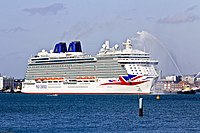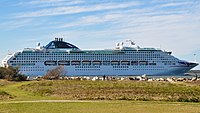Loading AI tools
British-American owned cruise line From Wikipedia, the free encyclopedia
P&O Cruises is a British cruise line based at Carnival House in Southampton, England, operated by Carnival UK and owned by Carnival Corporation & plc. It was originally a subsidiary of the freight transport company P&O and was founded in 1977.[1] Along with P&O Cruises Australia, another former subsidiary of P&O, it has the oldest heritage of any cruise line in the world, dating to P&O's first passenger operations in 1837.[3][4][5]
 | |
| Company type | Subsidiary |
|---|---|
| Industry | Hospitality and transportation |
| Predecessor | P&O |
| Founded | 1977[1] |
| Headquarters | Southampton, England, UK |
Area served | United Kingdom |
Key people |
|
| Products | Cruises |
| Revenue | $467 million (2021)[2] |
| Parent | Carnival Corporation & plc |
| Website | www |
Footnotes / references P&O House Flag | |
P&O Cruises was divested from P&O in 2000, subsequently becoming a subsidiary of P&O Princess Cruises,[6] before coming under its current ownership in 2003, following a merger between P&O Princess Cruises and Carnival Corporation (the combined company now operates as Carnival Corporation & plc).[7]
In 1834, Brodie McGhie Willcox, a ship broker from London, and Arthur Anderson, a sailor from the Shetland Islands, formed an association with Captain Richard Bourne, a steamship owner from Dublin.[8] In 1837, the trio won a contract and began transporting mail and passengers from England to the Iberian Peninsula, founding the Peninsular Steam Navigation Company.[9][5] In 1840, the company merged with the Transatlantic Steam Ship Company and expanded their operations to the Orient, becoming the Peninsular and Oriental Steam Navigation Company (P&O).[10] In 1844, P&O expanded its passenger operations from transportation to include leisure cruising, operating sailings from England to the Mediterranean that were the first of their kind.[5] By the mid-1900s, passenger shipping for the purposes of transportation was threatened by the increasing affordability of air travel.[11] Consequently, in the 1970s, P&O dedicated its passenger operations entirely to leisure cruising and, in 1977, relisted its passenger ships under the new subsidiary P&O Cruises.[1]

Initially, P&O Cruises operated Oriana and Canberra from Southampton, serving the UK market,[12][13] and Arcadia from Sydney, serving the Australian market,[14] while Uganda operated educational cruises.[15] All of these ships had previously operated for P&O and had been transferred to the new subsidiary. There were several changes over the following years. In 1979, Arcadia departed the Australian fleet[14] and was replaced by Sea Princess, which was formerly Kungsholm for Flagship Cruises.[16] In 1981, Oriana relocated to serve the Australian market,[12] and in 1982, Sea Princess relocated to serve the UK market.[16] The same year, both Canberra and Uganda were requisitioned to assist in the Falklands War, with the former becoming a troopship and the latter a hospital ship.[17][18]
More ships departed the fleet in the following years; Uganda in 1983,[18] Oriana in March 1986[19] and Sea Princess in November 1986.[16] With only Canberra remaining, serving the UK market,[4] P&O diverged its Australian operations from its UK operations in 1988, acquiring Sitmar Cruises, which already operated a ship in Australia.[12] This ultimately led to the formation of P&O Cruises Australia, which would oversee Australian operations, while P&O Cruises focused on UK operations.[3]

In the 1990s, P&O Cruises commissioned its first newbuild, the second Oriana, which entered service in April 1995.[20] Unlike the older ocean liners the company had inherited from P&O, which had originally been designed to transport passengers from one place to another, the new Oriana was a cruise ship, built purely for pleasure cruising. At 69,153 gross tons, she was one of the largest cruise ships in the world.[21] Sea Princess also returned to the fleet in 1995, now renamed Victoria.[16] Canberra departed the fleet in 1997 and was replaced the same year by a second Arcadia, formerly Star Princess for Princess Cruises.[13] In 2000, Aurora, another newbuild of similar design to Oriana, entered service,[22] although she suffered a disappointing start when she was forced to abandon her maiden voyage due to mechanical problems.[22]
The ownership of P&O Cruises changed twice in the early 2000s. In 2000, P&O divested its cruise operations and transferred them to the new independent company P&O Princess Cruises,[6] and in 2003, P&O Princess Cruises merged with Carnival Corporation to form Carnival Corporation & plc.[7]
Fleet rotations continued. Victoria departed for the final time in 2002,[16] Oceana, formerly Ocean Princess for Princess Cruises, joined the same year[23] and Arcadia departed in 2003.[24] Adonia, formerly Sea Princess and a sister to Oceana, replaced Arcadia the same year,[25] before being replaced by a newbuild Arcadia in 2005.[25] The new Arcadia had originally been intended for Holland America Line and later Cunard Line, but was allocated to P&O Cruises by Carnival during construction.[26][27] Arcadia was joined by Artemis, formerly Royal Princess for Princess Cruises.[28]

The fleet expanded and modernised with the addition of the 116,017-ton newbuild Ventura in 2008[29] and her sister Azura in 2010.[30] Artemis also departed the fleet in 2011[31] and was replaced by a second Adonia, which like Artemis had formerly been Royal Princess for Princess Cruises.[32]
In 2012, P&O Cruises celebrated the 175th anniversary of the Peninsular Steam Navigation Company by staging a 'Grand Event', in which the entire fleet was assembled in Southampton.[33]
The company's modernisation continued with the introduction of a new livery in 2014 based on the Union Jack, to emphasise its British heritage,[34] and the arrival of the 143,730-ton newbuild Britannia in 2015.[35] More departures followed; Adonia transferred to Carnival's new Fathom brand between 2016 and 2017,[36][37] before departing permanently in 2018,[38] and Oriana, the company's first newbuild, departed in 2019.[39]
In March 2020, P&O Cruises joined every cruise line worldwide in suspending passenger operations as a result of the COVID-19 pandemic.[40][41] This led to the departure of Oceana in July 2020, as Carnival sold older ships across its fleets in order to increase liquidity.[42] Operations would not resume until fifteen months later, in June 2021.[43]
The company continued to expand with the addition of the 184,089-ton newbuild Iona in 2020,[44] although her maiden voyage was delayed until the following year by the pandemic,[45][46] and her sister Arvia in 2022.[47] These became the first ships built for the British market to be powered by liquefied natural gas (LNG), rather than fuel oil, in an effort to make them more environmentally friendly.[48][49]
In March 2022, P&O Cruises suffered a public backlash following a mass firing of staff by P&O Ferries, another former subsidiary of P&O.[50] They subsequently embarked on an advertising campaign in national newspapers and on social media to clarify their separate ownership.[50]
On 23 November 2023, it was reported that P&O Cruises, alongside Cunard, has taken steps to implement a "fire and rehire" strategy for over 900 crew members based in the UK, if staff did not accept new terms of salary reductions and the adoption of new working conditions.[51] Carnival UK had notified the authorities that it was considering redundancies, by submitting a Form HR1 to the UK government’s Insolvency Service, just a day after starting talks with the union over reducing workers' hours and pay.[52] The union representing the workers at P&O, Nautilus International, criticised Carnival UK saying the move suggested that Carnival "never had any intention of 'meaningful negotiation'".[53] A day later Carnival UK rescinded the HR1 form and the threat of the use of a "fire and rehire" strategy following urgent talks with Nautilus, saying both parties were “committed to engaging in meaningful consultation”.[54]
P&O Cruises awards the company's Golden Cockerel trophy to the fastest ship in its fleet.[13] The trophy is currently held by Aurora, which achieved a speed of 25.7 knots in April 2019.[55] It was previously held by the first Oriana until her retirement in 1986,[13] Canberra until her retirement in 1997,[13] and the second Oriana until her retirement in 2019.[56]
| Ship | Built | Builder | Entered service | Gross tonnage | Flag[57] | Notes | Image |
|---|---|---|---|---|---|---|---|
| Aurora | 2000 | Meyer Werft | 2000 | 76,152 |
Has held the Golden Cockerel trophy since 2019[55] |
 | |
| Arcadia | 2005 | Fincantieri | 2005 | 84,342 |  | ||
| Ventura | 2008 | Fincantieri | 2008 | 116,017 |  | ||
| Azura | 2010 | Fincantieri | 2010 | 115,055 |  | ||
| Britannia | 2015 | Fincantieri | 2015 | 143,730 |  | ||
| Iona | 2020 | Meyer Werft | 2021 | 184,089 | Joint largest cruise ship ever built for the UK market with Arvia[58] |  | |
| Arvia | 2022 | Meyer Werft | 2022 | 185,581[59] | Joint largest cruise ship ever built for the UK market with Iona[58] |  |
| Ship | Built | Builder | In service | Gross tonnage | Flag | Notes | Image |
|---|---|---|---|---|---|---|---|
| Arcadia | 1954 | John Brown & Company | 1977–1979 | 29,734 |  | ||
| Uganda | 1952 | Barclay Curle | 1977–1983 | 14,430 |
|
 | |
| Oriana | 1960 | Vickers-Armstrong | 1977–1986 | 41,910 |  | ||
| Canberra | 1961 | Harland and Wolff | 1977–1997 | 49,073 |
|
 | |
| Sea Princess /Victoria | 1965 | John Brown & Company | 1979–1986 (as Sea Princess), 1995–2002 (as Victoria) | 27,670 |
|
 | |
| Arcadia | 1988 | Chantiers de l'Atlantique | 1997–2003 | 63,500 |
|
 | |
| Adonia | 1998 | Fincantieri | 2003–2005 | 77,499 |
|
 | |
| Artemis | 1984 | Wärtsilä | 2005–2011 | 44,348 |
|
 | |
| Adonia | 2001 | Chantiers de l'Atlantique | 2011–2016, 2017–2018 | 30,277 |
|
 | |
| Oriana | 1995 | Meyer Werft | 1995–2019 | 69,153 |  | ||
| Oceana | 2000 | Fincantieri | 2002–2020 | 77,499 |
|
 | |
Seamless Wikipedia browsing. On steroids.
Every time you click a link to Wikipedia, Wiktionary or Wikiquote in your browser's search results, it will show the modern Wikiwand interface.
Wikiwand extension is a five stars, simple, with minimum permission required to keep your browsing private, safe and transparent.